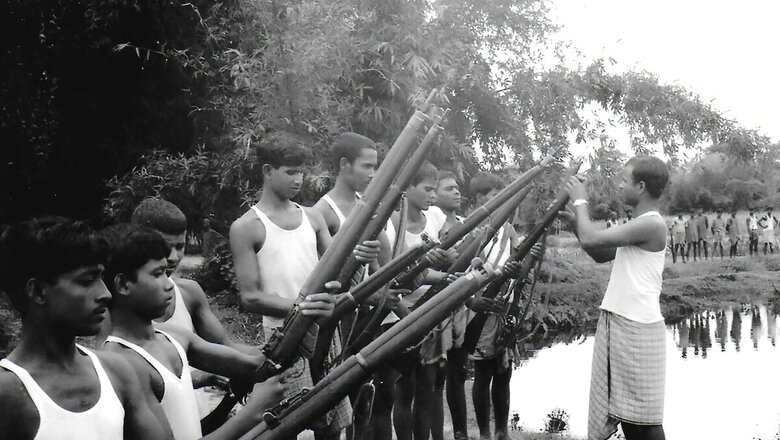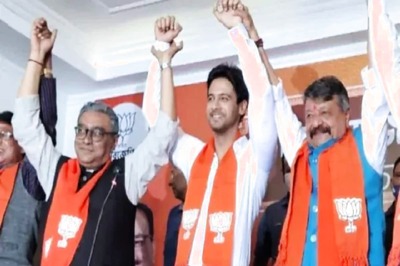
views
With Bangladesh celebrating 50 years of Independence, an account by retired Air Vice Marshal Arjun Subramaniam on how Mukti Bahini, the Bangladesh Forces, were trained by Indian commanders.
Initially formed as the Mukti Fauj or the Mukti Bahini, or simply the ‘Freedom Fighters’ when translated into English, the force primarily comprised the armed organizations that fought alongside the Indian armed forces against the Pakistan Army during the Bangladesh Liberation War. It was dynamically formed by Bengali regulars and civilians after the proclamation of Bangladesh’s independence on 26 March 1971. Subsequently, by mid-April 1971, the former members of the East Pakistan armed forces formed the ‘Bangladesh Armed Forces’ and M.A.G. Osmani assumed their command. The civilian groups continued to assist the armed forces during the war. After the war ‘Mukti Bahini’ became the general term to refer to all forces of former East Pakistani origin fighting against the Pakistani armed forces during the Bangladesh liberation war. Inspired in part by the revolutionary Che Guevara, the Mukti Bahini operated as a highly effective guerrilla force to keep the Pakistan Army on tenterhooks.
The ‘soldier nucleus’ of the Mukti Bahini comprised regular officers and men of the East Bengal Rifles (EBR) who rebelled against the Pakistan Army after the crackdown of March 1971. Led by commanders like Colonel Osmani and Major Zia-ur-Rahman (later president of Bangladesh), they operated in a diffused manner alongside local commanders like ‘Tiger’ Siddiqui with two primary objectives. The first was to exert pressure on the Pakistan Army from the periphery using Indian territory as firm bases; the second and more dangerous one was to chip away at the core of Pakistan’s defences in the heartland by carrying out hit-and-run attacks and then melting away into the countryside.
ALSO READ| 1971 Indo-Pak War: Story of Pakistan’s Surrender and Liberation of Bangladesh
India’s role in indoctrinating, training and equipping the Mukti Bahini prior to the commencement of actual operations in December 1971 is well documented from both the intelligence and military angle. It had identified as early as 1968 that East Pakistan offered immense potential for covert action—this emerged as one of the two main tasks assigned by Prime Minister Indira Gandhi to the Research and Analysis Wing (R&AW). R&AW was hived off from the Intelligence Bureau (IB) to develop covert capability; East Pakistan was one of its first tests. After influencing sections of the East Bengali intelligentsia to rise against the dominating West Pakistani leadership, Mujib’s electoral success and Yahya’s crackdown provided the much-needed fillip for expansion of these operations. Much before the Indian Army took over the role of training the Mukti Bahini, R&AW had already commenced training small groups of volunteers and pushing them inside East Pakistan. When large elements of the East Bengal Rifles revolted and crossed over to India, the Indian Army took over the mandate of converting this guerrilla force into one, which was capable of supporting it during full-fledged operations.
Contrary to rather far-fetched claims by Niazi that the total strength of the Mukti Bahini was over 2,50,000 trained and armed fighters, a more realistic figure pointed at a little over a two-division-sized force of regulars comprising remnants of the East Pakistan Rifles, East Bengal Regiment, civil police and around 50,000 irregulars and guerrillas trained by India to wage war on Niazi’s formations. Split into battalion groups along the three-sided border with India with specific sectors and sub-sectors assigned to each group, the Mukti Bahini initially operated through the Border Security Force (BSF) sectors; they later merged effortlessly into the various Indian Army formations when they massed along the border in preparation for the final assault into East Pakistan. Significant credit for raising the war-fighting potential of this force must go to Indian field commanders like Brigadier Shabeg Singh and Brigadier Sant Singh, who worked tirelessly with Mukti Bahini commanders like Major Zia-ur-Rahman to create brigade-sized forces which had the confidence of taking on fortresses at places like Kamalpur and Jessore. Shahbeg would later gain notoriety for his role as the principal military commander of Sant Jarnail Singh Bhindranwale, the Sikh terrorist leader who fought the Indian Army in the early 1980s before being killed inside the Golden Temple during Operation Bluestar in 1984.
Most accounts of the growth of the Mukti Bahini do not do justice to its naval and air wings. Mukti Bahini frogmen operated with freedom in the riverine areas of Chittagong, Chalna and Khulna and played an important role in interdicting supplies coming in from the sea to support the occupation forces in the eastern part of Bangladesh. Led by Bengali sailors and submariners who defected from the Pakistan Navy, particularly from the Daphne class submarine PNS Mangro, they specialized in mining water channels and placing limpet mines, causing incalculable damage to Pakistan’s trade and shipping. Lloyds of London hiked its insurance rates for the area after the frogmen sunk over 1,00,000 tons of merchant shipping from July to November 1971, and damaged another 50,000 tons. The naval element of the Mukti Bahini was later called Force Alpha as it integrated with the Indian Navy as the war progressed.
ALSO READ| Bangladesh to Construct Monument for Indian Soldiers Martyred in 1971 Liberation War: Minister
Many Bengali officers and men from the Pakistan Air Force and Pakistan International Airlines (PIA) joined the Mukti Bahini and quickly made the transition to being ‘land warriors’. Many of them, like Wing Commander Bashar, were sector commanders and participated in raids. However, the aspiration to form an air wing remained – it only needed some support from India in the form of an airfield and a few aircraft to fructify into a reality. It was not long before Air Chief Marshal P.C. Lal, himself a Bengali, realized the potential of such a force and gifted a few aircraft and assigned a base to ‘Kilo Force’, as the fledgling Bangladesh Air Force came to be known in late September 1971. Operating out of Dimapur, a small airstrip in Nagaland, Kilo Force was commanded by Group Captain Khandokar, who later became the first chief of the Bangladesh Air Force. It had on its inventory a Dakota freighter aircraft, an Otter light transport aircraft and an Alouette helicopter. The Otter and Alouette were suitably modified to fire rockets and guns: they would extensively take part in ground support operations during the conflict. Group Captain Chandan Singh, a highly accomplished transport pilot of the IAF and station commander of the air force station at Jorhat in Assam, mentored the fleet with an ace IAF helicopter pilot, Flight Lieutenant Singla, attached as an instructor. With his eye for talent, Lal picked Chandan Singh as his key interface man with the Indian Army’s IV Corps, which would go on to blaze new trails of joint operations during the ensuing conflict.
Read all the Latest Opinions here



















Comments
0 comment